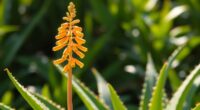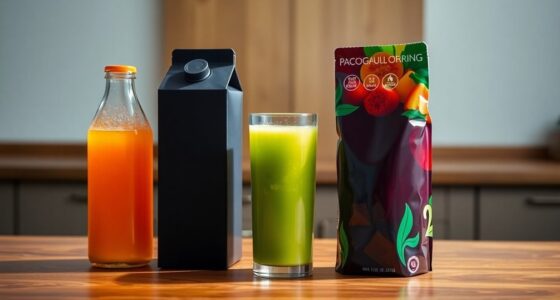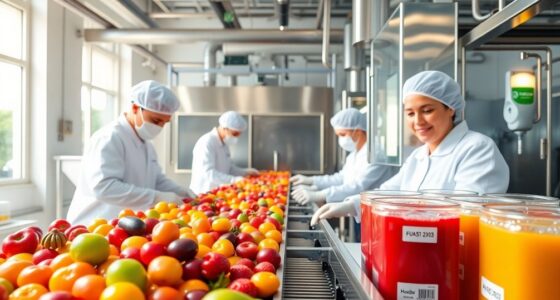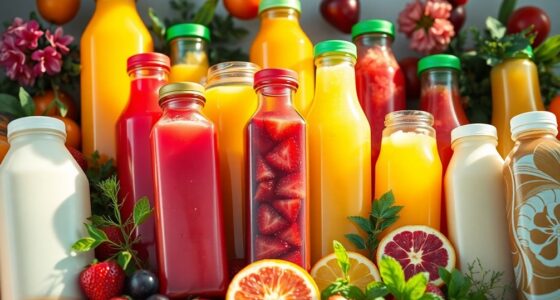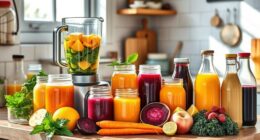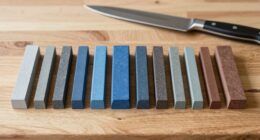Making your own fresh fruit juice at home gives you control over what goes into your drink, ensuring it's free from unwanted sugars and preservatives. It's a fun activity the whole family can enjoy, letting you experiment with various flavors and ingredients. Plus, you can pack in the nutrients with fruits, veggies, and herbs you love. Why not explore some creative combinations and easy methods to get started? There's so much more to discover!
Key Takeaways
- Homemade juice allows you to control ingredients, ensuring a healthier and more natural option without unwanted additives.
- Juicing engages family members, making it a fun activity that can teach kids about healthy eating.
- Freshly made juice delivers superior flavor and nutritional benefits compared to store-bought options.
- Experimenting with different fruit and vegetable combinations encourages creativity and increases your intake of vitamins and minerals.
- Making your own juice can be more cost-effective than purchasing pre-made juices, saving money in the long run.
The Joys of Homemade Juice
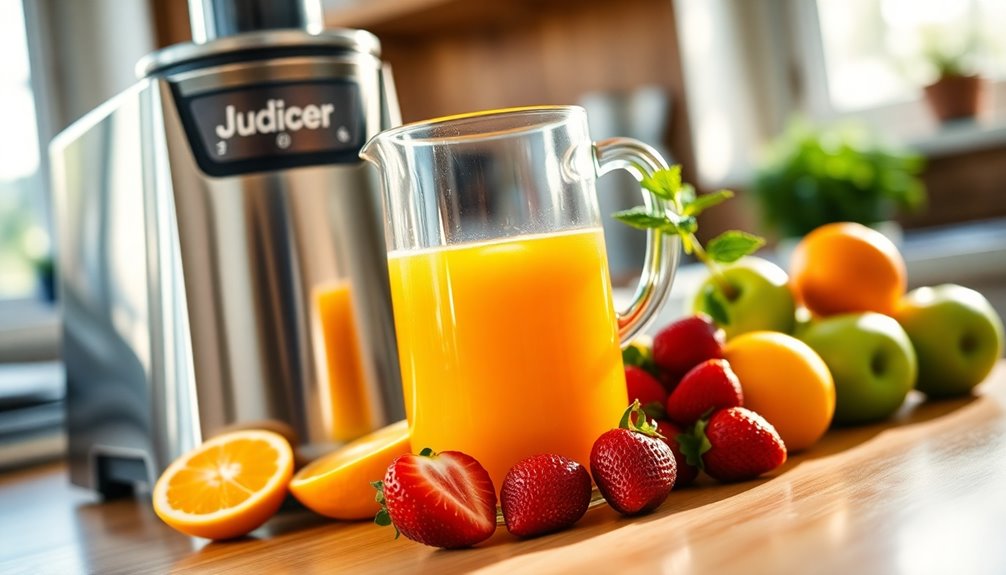
When you make homemade juice, you're not just creating a beverage; you're crafting a healthier option that lets you control every ingredient.
The joy of fresh juice lies in knowing it's free from unwanted sugars and preservatives, offering pure, natural nutrients.
It's a quick and easy process, turning juice-making into a fun family activity where kids can watch their favorite fruits transform into delicious drinks.
Plus, the versatility encourages you to experiment with exciting flavor combinations, like peach with ginger or mango with lime.
Enjoying your juice fresh and immediately enhances both flavor and nutritional benefits, making homemade juice a delightful choice compared to store-bought options that often lose quality over time. Additionally, using fresh ingredients can significantly enhance the flavor and nutrition of your juice.
Essential Ingredients for Fresh Juice
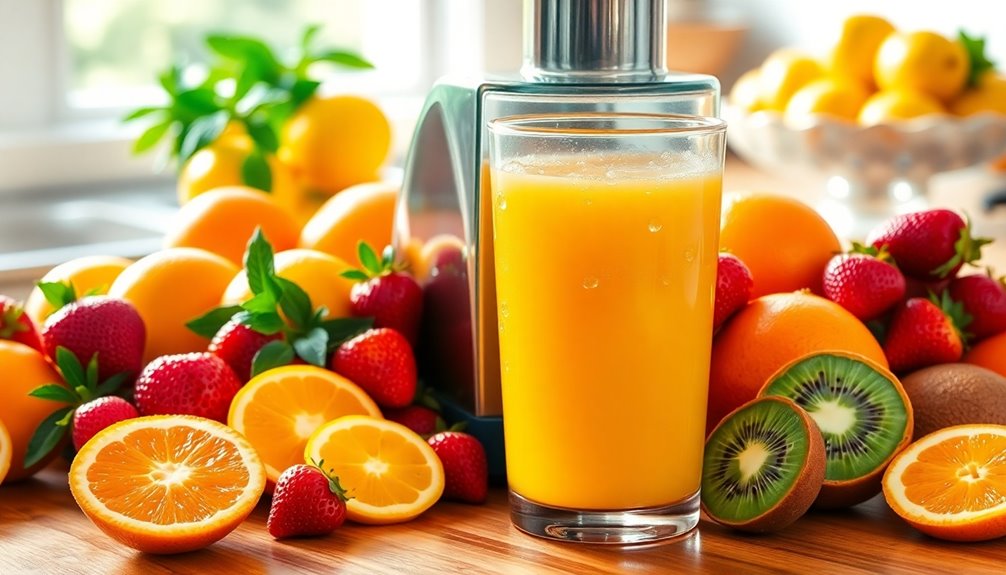
Creating fresh juice requires just a handful of essential ingredients that can elevate your drink from ordinary to extraordinary.
Start with a variety of fruits like apples, oranges, and berries for natural sweetness and rich flavor. Incorporate citrus fruits such as lemons or limes to add a zesty tartness that balances the sweetness.
High-yield fruits and vegetables like cucumbers and celery help maximize juice volume while keeping it invigorating. Don't forget to include herbs like mint or basil for an aromatic twist that pairs beautifully with your fruit combinations.
For added nutritional benefits, leafy greens like spinach or kale can enrich your juice with vitamins and minerals without altering the taste appreciably.
These are the essential ingredients for fresh juice you won't want to miss!
Step-by-Step Guide to Juicing

To make the best fresh fruit juice, start by choosing your ingredients wisely. You'll want to master simple blending techniques to extract all that delicious flavor, then strain the mixture for a smooth finish. Incorporating exotic fruit blends can elevate your juice's flavor profile and nutritional value. Let's break down each step to guarantee your juice turns out perfectly every time.
Choosing Your Ingredients
Choosing the right ingredients is essential for crafting a delicious and nutritious fresh fruit juice. Start by selecting a mix of fruits, vegetables, herbs, and spices to create a balanced flavor profile. Here's a handy table to guide you:
| Sweet | Tart | Earthy |
|---|---|---|
| Apples | Lemons | Beets |
| Pineapples | Limes | Kale |
| Oranges | Grapefruit | Carrots |
Chop tougher ingredients into smaller pieces and pack leafy greens tightly for ideal blending. Always include a liquid like water or coconut water for smooth consistency. Additionally, you might consider incorporating chia seeds into your juice for added nutritional benefits. Experiment with combinations to enhance taste while keeping in mind the importance of choosing your ingredients when you juice at home!
Simple Blending Techniques
Once you've picked your favorite fruits and vegetables, it's time to get blending.
Start by washing your ingredients thoroughly and cutting them into small pieces.
Next, place the chopped fruits or veggies into a blender, adding a splash of water or juice to help the blending process.
Use simple blending techniques by blending the mixture until it reaches a smooth consistency, which may take a few minutes.
If you want to enjoy juice without a juicer, this method works perfectly!
Blend until everything is well incorporated, and then you can savor your freshly made juice.
Don't forget to try different combinations for unique flavors.
To maximize the health benefits, consider adding nutrient-dense greens like spinach to your juice for added vitamins and minerals.
Enjoy your juice immediately for the best taste and nutrition!
Straining for Smooth Juice
Straining your juice is an essential step to achieve that smooth, revitalizing texture you crave.
To start, place a fine-mesh sieve or strainer over a bowl, and consider lining it with cheesecloth for better filtration. Slowly pour the blended mixture into the sieve, letting the liquid drain while the fibrous pulp stays behind.
Use a spoon or measuring cup to gently press the pulp, extracting more juice and maximizing your yield. If you want the smoothest juice possible, repeat the straining process to guarantee a pulp-free final product.
Don't forget to discard the leftover pulp, or use it in other recipes to minimize waste. Enjoy the invigorating taste of your freshly strained juice! Additionally, consider using beet juice for its many health benefits, including improved blood circulation and enhanced stamina.
Creative Flavor Combinations to Try
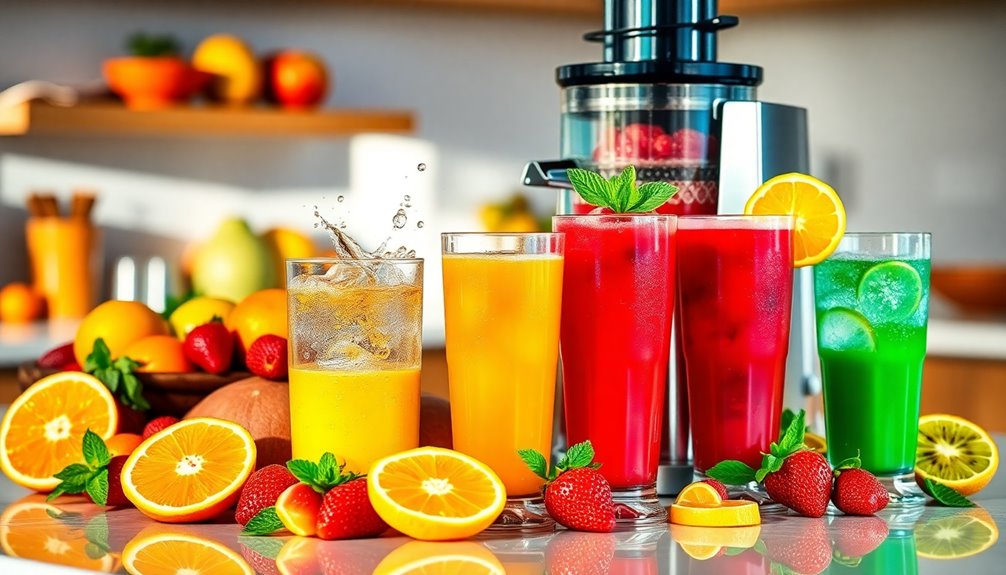
If you're looking to elevate your juice game, experimenting with creative flavor combinations can be a delightful adventure. Mixing unexpected ingredients can lead to invigorating and unique fruit juice blends.
Here are some creative flavor combinations to try:
- Ripe peaches with spicy ginger for a zesty kick.
- Strawberries paired with aromatic basil, perfect for summer.
- Mango combined with lime juice for a tropical twist.
- Apples blended with carrots for a nutrient-packed boost.
Don't hesitate to mix and match various fruits and herbs, like cucumber and mint, to discover personalized flavors.
Each combination offers a unique taste experience that can awaken your palate and make your homemade juices even more enjoyable.
Happy juicing!
Juicing Without a Juicer: A Simple Method
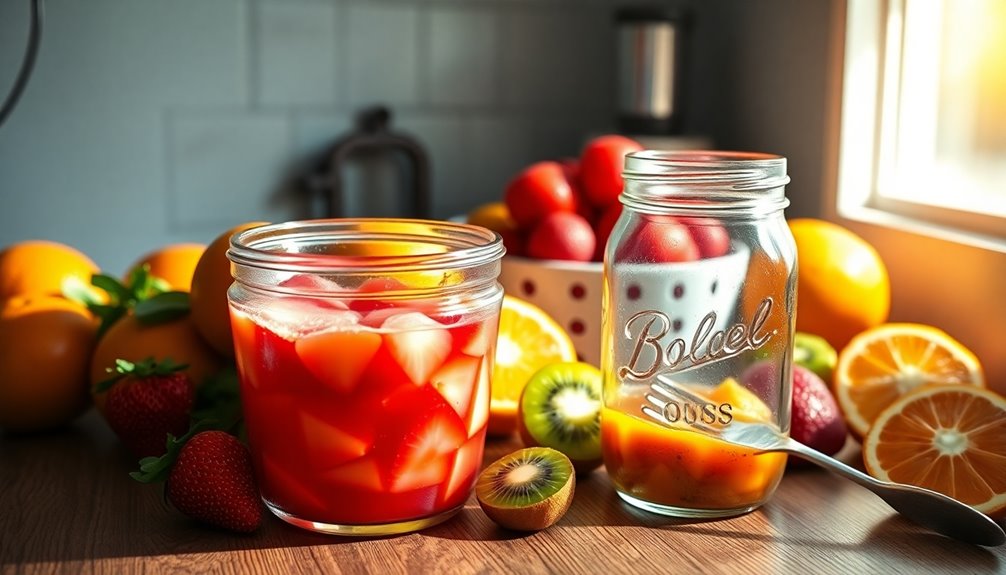
You don't need a fancy juicer to enjoy fresh fruit juice at home.
With just a blender and a few simple tools, you can create delicious juice from your favorite fruits. Start by selecting ripe, juicy fruits such as oranges, apples, and berries for an added burst of flavor. Next, chop them into smaller pieces, which will make blending easier and ensure a smooth consistency. These are truly some of the best methods for fresh juice, allowing you to enjoy a nutritious drink packed with vitamins and natural sweetness right at home.
Let's explore the basic equipment you'll need and some alternative blending techniques that make this process easy and effective.
Basic Equipment Needed
Creating fresh fruit juice at home is easier than you might think, even without a juicer. All you need is some basic equipment to get started. Here's what you'll need:
- A blender for mixing your fruits
- A fine-mesh sieve or cheesecloth for straining
- A bowl to catch the juice
- Glass bottles for storage
Begin by washing and chopping your chosen fruits into small pieces. Blend them with a bit of water to facilitate extraction.
Pour the mixture into the sieve set over the bowl, pressing with a spoon to extract juice from the pulp. If you want a smoother texture, strain the juice again.
Store it in glass bottles, and consider boiling them for about 10 minutes for preservation. Additionally, using fresh fruits like celery juice can enhance the nutritional value of your homemade juice. Enjoy!
Alternative Blending Techniques
While most people associate juicing with specialized machines, you can achieve delicious results using just a blender.
To make juice without a juicer, start by washing and chopping your chosen fruits or vegetables into small pieces. Blend these ingredients with a small amount of water or coconut water to help achieve a smoother consistency.
After blending, strain the mixture through a fine-mesh sieve or cheesecloth to separate the juice from the fibrous pulp. This method showcases alternative blending techniques that yield a revitalizing drink.
For added flavor, mix in herbs like mint or basil, or a splash of citrus juice. Freshly squeezed juice retains more nutrients than processed juice, making it a healthier option.
Don't forget to use the pulp in smoothies or baking to minimize waste and maximize your ingredients!
Tips for Straining and Serving Your Juice

Straining and serving your freshly made juice can elevate the experience, allowing you to enjoy a smooth and flavorful drink.
Here are some tips for making juice that'll help you get the most out of your effort:
- Use a fine-mesh sieve or strainer lined with cheesecloth to catch pulp effectively.
- Pour the blended mixture slowly to let the juice drain while the pulp remains.
- Press down on the pulp with a spoon to extract every last drop of juice.
- Serve immediately for the best flavor, and garnish with fresh herbs or fruit slices for a beautiful presentation. Additionally, be sure to check for expiration dates on your ingredients to ensure freshness and safety.
These steps guarantee your juice isn't only delicious but also visually appealing, making it a treat for both the palate and the eyes!
Enhancing Fresh Juice With Unique Ingredients

After you've mastered the art of straining and serving your juice, it's time to explore ways to enhance it with unique ingredients. Mixing in fresh herbs like basil or mint can elevate the flavor without extra sugars. A splash of citrus juice, such as lemon or lime, brightens the taste while boosting vitamin C. Spices like ginger or cinnamon add warmth and complexity, aiding digestion. Don't forget about vegetables—blending in spinach or kale enhances nutrition and adds a vibrant color. For added texture and nutrients, consider superfoods like chia or flaxseeds for their omega-3 fatty acids. Additionally, incorporating honey, such as rapeseed honey, can provide a natural sweetness while offering various health benefits, including antioxidants that combat oxidative stress.
| Ingredient Type | Benefits |
|---|---|
| Herbs | Invigorating flavor |
| Citrus Juice | Brightens & boosts vitamin C |
| Spices | Adds warmth & aids digestion |
| Vegetables | Nutritional boost & color |
| Superfoods | Texture & omega-3s |
Storing and Preserving Your Juice

To guarantee your freshly made fruit juice stays flavorful and nutritious, it's essential to store it properly. Fresh juice can lose its freshness quickly due to oxidation, so follow these tips to help your juice stay fresh longer:
- Use airtight containers to limit oxygen exposure.
- Keep your juice in the refrigerator for short-term storage.
- Consider freezing it for up to 6 months; just thaw it in the fridge before drinking.
- Add natural preservatives like ascorbic or citric acid to slow browning.
Maintaining a pH level of 3.0 to 4.0 can also help inhibit harmful bacteria growth.
With these methods, you'll enjoy your delicious juice for days while preserving its vibrant flavor and nutrients!
Health Benefits of Juicing at Home

When you juice at home, you gain complete control over what goes into your drink, avoiding unwanted additives and ensuring nutrient-rich ingredients.
This not only enhances your health but can also save you money compared to store-bought options.
Plus, you get to experiment with flavors, making it a fun way to boost your daily intake of fruits and vegetables.
Nutrient-Rich Ingredients
Juicing at home offers a delicious way to pack your diet with essential nutrients. By blending fresh fruits and leafy greens, you can create vibrant juices that boost your health. Here are some benefits you'll enjoy:
- Vitamin C from citrus fruits strengthens your immune system and enhances skin health.
- Leafy greens like kale and spinach provide antioxidants, fiber, iron, and calcium for overall wellness.
- Fruits high in potassium, such as bananas and oranges, help regulate blood pressure and support heart health.
- Adding herbs and spices like ginger and turmeric enhances anti-inflammatory effects and improves digestion.
- Incorporating seeds like chia can further enrich your juice with omega-3 fatty acids, promoting heart health and overall well-being.
With these nutrient-rich ingredients, your homemade juice can become a powerhouse of health benefits, making it easy to nourish your body every day!
Control Over Additives
By choosing to make your juice at home, you gain complete control over what goes into your drink, ensuring it's free from added sugars and preservatives often found in store-bought options. This means you can savor pure, natural nutrients while maximizing health benefits.
| Benefit | Homemade Juice | Store-Bought Juice |
|---|---|---|
| Additives | No added sugars/preservatives | Often contains sugars/preservatives |
| Nutrient Retention | High | Potentially low |
| Customization | Tailored to taste | Limited options |
| Engagement | Fun for kids to learn | No interaction |
Making juice at home promotes healthier drinking habits, as you can adjust flavors and sweetness. Plus, it teaches kids about healthy eating, ensuring they enjoy delicious, additive-free beverages.
Cost-Effective Health Solution
Making fresh fruit juice at home isn't just a healthier choice; it's also a wallet-friendly solution. By juicing at home, you can save money while enjoying a nutritious drink. You'll control the ingredients and avoid excess sugars and preservatives found in store-bought options.
Plus, you can make large batches, allowing you to juice longer without breaking the bank.
- Enjoy concentrated vitamins and minerals.
- Increase your fruit and vegetable intake effortlessly.
- Use seasonal produce for better flavor and nutrition.
- Foster healthier habits while saving money.
Ultimately, homemade juice is a cost-effective health solution that promotes well-being and supports your budget.
Engaging Kids in the Juicing Process

How can you turn a simple juicing session into an exciting learning experience for your kids? Start by involving them in selecting fresh fruits and vegetables at the market. This helps them stay connected to where their food comes from.
Once home, let them wash, cut, and blend the ingredients. This hands-on experience not only improves their fine motor skills but also makes them feel like real chefs.
As they watch whole fruits transform into juice, you can spark curiosity with a fun science lesson about food properties. Encourage them to customize their juice recipes, allowing their creativity to shine.
This way, juicing becomes not just a healthy activity but also an engaging opportunity for learning and expression.
Frequently Asked Questions
Is Making Your Own Fruit Juice Healthy?
Yes, making your own fruit juice is healthy! You control what goes in, so you can avoid added sugars and preservatives.
Fresh juice retains more nutrients and antioxidants compared to store-bought options. Plus, you can mix different fruits and veggies, boosting your vitamin and fiber intake.
It's also a fun activity you can do with your family, helping everyone appreciate the benefits of fresh produce while enjoying a revitalizing, healthier drink.
What Vegetables Should Not Be Juiced?
When you're juicing, steer clear of starchy vegetables like potatoes and corn; they don't yield good juice.
Also, avoid strong-flavored veggies like garlic and Brussels sprouts, as they can overpower your drink.
Fibrous vegetables such as artichokes and asparagus aren't great either since they produce little juice and may clog your juicer.
Finally, use beets sparingly; their earthy taste can dominate if not balanced with sweeter ingredients.
What Is the 80 20 Rule for Juicing?
Think of juicing like painting a masterpiece; you need a balanced palette!
The 80/20 rule for juicing suggests that 80% of your juice should come from vegetables, while 20% should come from fruits. This balance helps maintain a lower sugar content and keeps your glycemic index in check.
Why Should We Drink Fresh Fruit Juice Instead of Canned Juice?
You should drink fresh fruit juice instead of canned juice because it's free from added sugars and preservatives, giving you pure, natural flavors.
Homemade juice retains higher vitamin and mineral concentrations since it doesn't undergo heat treatment.
You've got full control over ingredients, allowing you to customize sweetness and flavors to your taste.
Plus, consuming it immediately guarantees peak freshness, which canned options often lack due to their shelf life.
Enjoy the difference!
Conclusion
So, why not turn your kitchen into a vibrant juice bar? Imagine the burst of color as you blend sun-kissed oranges, ripe strawberries, and invigorating mint leaves, filling your home with the sweet aroma of freshness. By making your own juice, you're not just enjoying delicious flavors; you're embracing a healthier lifestyle. Grab those fruits, release your creativity, and sip on the joy of homemade goodness—your taste buds will thank you!
Cindy thoroughly researches juicing trends, techniques, and recipes to provide readers with practical advice and inspiration. Her writing style is accessible, engaging, and designed to make complex concepts easy to understand. Cindy’s dedication to promoting the advantages of juicing shines through her work, empowering readers to make positive changes in their lives through the simple act of juicing.


